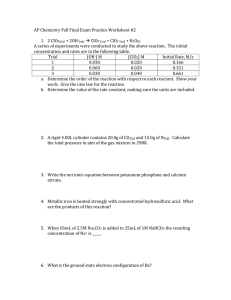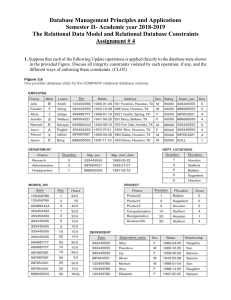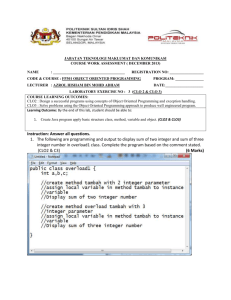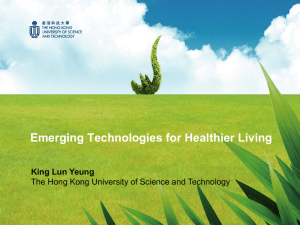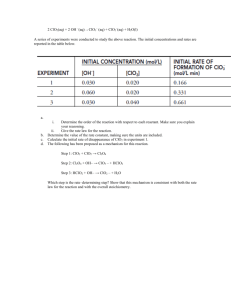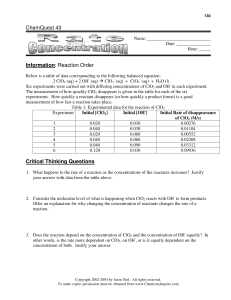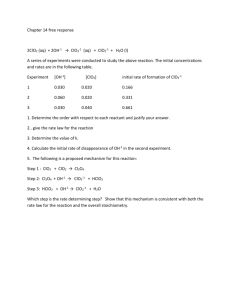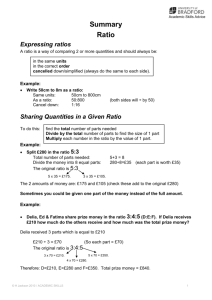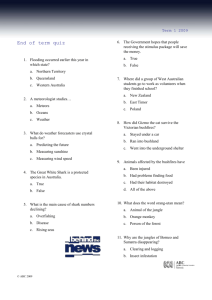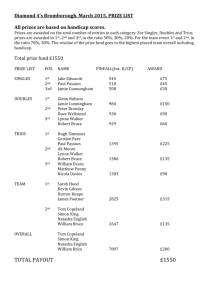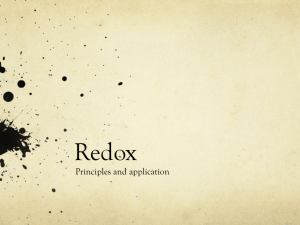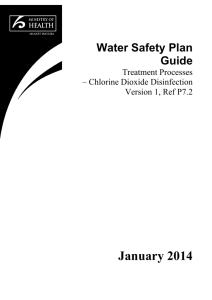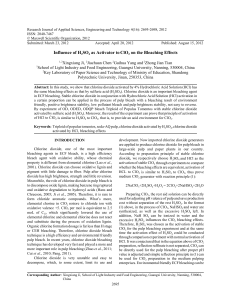Laudation - Swedish Chamber
advertisement
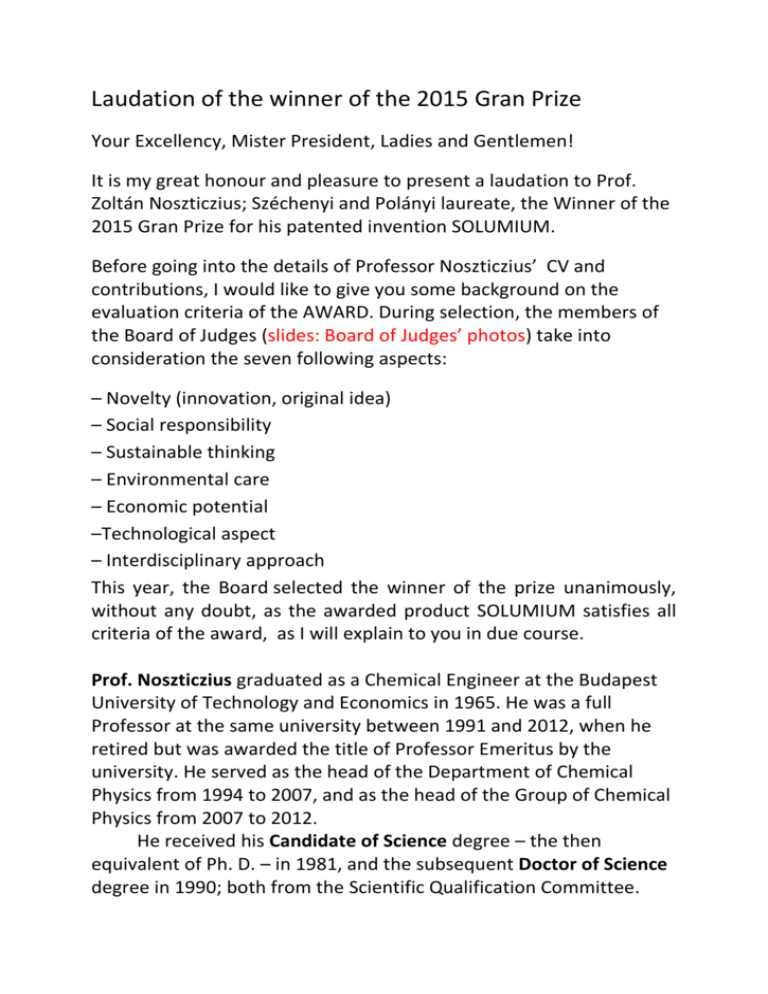
Laudation of the winner of the 2015 Gran Prize Your Excellency, Mister President, Ladies and Gentlemen! It is my great honour and pleasure to present a laudation to Prof. Zoltán Noszticzius; Széchenyi and Polányi laureate, the Winner of the 2015 Gran Prize for his patented invention SOLUMIUM. Before going into the details of Professor Noszticzius’ CV and contributions, I would like to give you some background on the evaluation criteria of the AWARD. During selection, the members of the Board of Judges (slides: Board of Judges’ photos) take into consideration the seven following aspects: – Novelty (innovation, original idea) – Social responsibility – Sustainable thinking – Environmental care – Economic potential –Technological aspect – Interdisciplinary approach This year, the Board selected the winner of the prize unanimously, without any doubt, as the awarded product SOLUMIUM satisfies all criteria of the award, as I will explain to you in due course. Prof. Noszticzius graduated as a Chemical Engineer at the Budapest University of Technology and Economics in 1965. He was a full Professor at the same university between 1991 and 2012, when he retired but was awarded the title of Professor Emeritus by the university. He served as the head of the Department of Chemical Physics from 1994 to 2007, and as the head of the Group of Chemical Physics from 2007 to 2012. He received his Candidate of Science degree – the then equivalent of Ph. D. – in 1981, and the subsequent Doctor of Science degree in 1990; both from the Scientific Qualification Committee. During his scientific career, he studied transport processes like diffusion and membrane transport, oscillatory chemical reactions, chemical waves and reaction-diffusion or Turing patterns. For his achievements in these fields, he received the Széchenyi Prize in 1990, and the Polányi Prize in 2003. He spent several years abroad at various universities, among others 4.5 years in Texas, and one year in Germany, as a visiting scientist and professor. (slide 1) He has begun dealing with chlorine dioxide during his research work on Turing patterns and nonlinear chemical dynamics. He soon learned that ClO2 is far more than a simple “nonlinear” reactant; it is a highly effective disinfectant, or, in other words, the “ideal biocide”. When Professor Noszticzius realized in 2006 that this compound can be applied as a very effective, environment- and human-friendly disinfectant, he decided to initiate a research concerning its highly beneficial properties. He and his co-workers achieved three major results in that work which is now recognized by the Gran Prize of 2015: 1. Invention of a process to produce high purity chlorine dioxide („Solumium”) solutions, patented in several countries including the US and Sweden, 2. Foundation of the company SOLUMIUM Ltd., to commercialise these solutions, and 3. The scientific discovery that ClO2 is a size-selective disinfectant that guarantees the advantageous medical applications of Solumium. (slide 2) 1. The basis of the invention is the discovery that all silicone rubbers can be applied as a selective membrane for ClO2 transmission. While ClO2 is able to permeate through such a membrane so rapidly as if it were made of liquid water, silicone rubber is practically impermeable for any other water-soluble component of a ClO2-producing aqueous reaction mixture. Using the silicone rubber permeation, high purity ClO2 solutions can be manufactured simply and effectively. This process has been patented. (slide 3) 2. Professor Noszticzius – together with his son Vilmos – founded the company Solumium Ltd. in 2007 to produce and commercialise the hyperpure chlorine-dioxide solutions. (slides 4–6) At present, the company has three products: Solumium Dental, Solumium Oral and Solvocid, what you can see here in the exhibition room as well. The advantageous properties of these products are summarized in the “Solumium, the 7-star disinfectant” flyer. (slide 7) 3. It has been known that, while ClO2 solutions kill bacteria within seconds, the very same solutions are not harmful for humans. One can even drink them in a considerable quantity without any negative consequences. However, there was no known explanation for this unexpected selectivity between bacteria and humans. ClO2 reacts quite quickly with four amino acids contained in the proteins of all living creatures among the 20 amino acids building them. Thus, the chemical selectivity of the traditional antimicrobial drugs cannot play any role in this case. (slides 8-12) Professor Noszticzius and co-workers could prove that it is the size of the living creatures that really matters in selectivity. Bacteria – for example Staphylococcus Aureus (“Staph”) – are much smaller than human cells, not to mention the human body. Applying a reaction-diffusion model, Professor Noszticzius’ team have shown that the “killing time” of a living organism is proportional to the square of its characteristic size. This way, small cells are killed nearly instantaneously, while big ones can survive if the contact time with ClO2 is not extremely long. Their results were published, end of 2013, in the scientific journal Plos One. (slide 13) It is important to mention that chlorine-dioxide is effective against all kinds of microbes, including viruses. This is rather obvious, as viruses, and especially their receptors, are even smaller than bacteria. For example, the diameter of the infamous Ebola virus is only 50 nm and its receptors are only few nm in length (slide 14), compared to the roughly 1000-times larger human cells. A virus becomes ineffective when its receptors are damaged by ClO2. Closing remark Nowadays, the fight against antimicrobial resistance is of global importance. Sweden accepted a leading role in this battle when initiating the global REACT network as early as 2004 (slide 15). In this respect, it is important to remark that bacteria are not able to develop resistance against chlorine dioxide, as it was pointed out in the previously mentioned publication by Prof. Noszticzius and coauthors. As Solumium is a local disinfectant, which can be used only on the outer and inner surfaces of the body (on skin and wounds, or on mucous membranes of the body like mouth or throat), it can replace antibiotics in these applications. This way, we hope that Solumium will be helpful in the global fight against antimicrobial resistance. (slide 16) Professor Noszticzius and his team presented an outstanding socially responsible attitude and strong commitment to provide a smart solution to mankind for this fight. By awarding him and his team, the Swedish Chamber of Commerce in Hungary pays its deepest respect for this work. Professor Noszticzius, I would like to thank you again on behalf of the Gran Prize Board of Judges! Congratulations!
